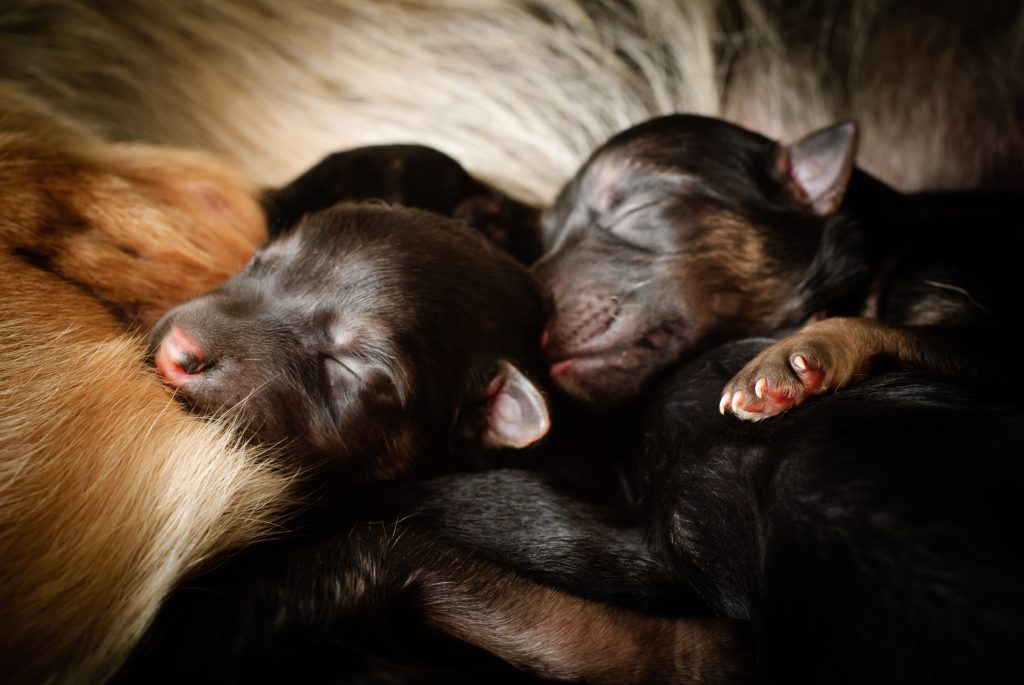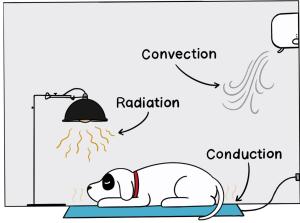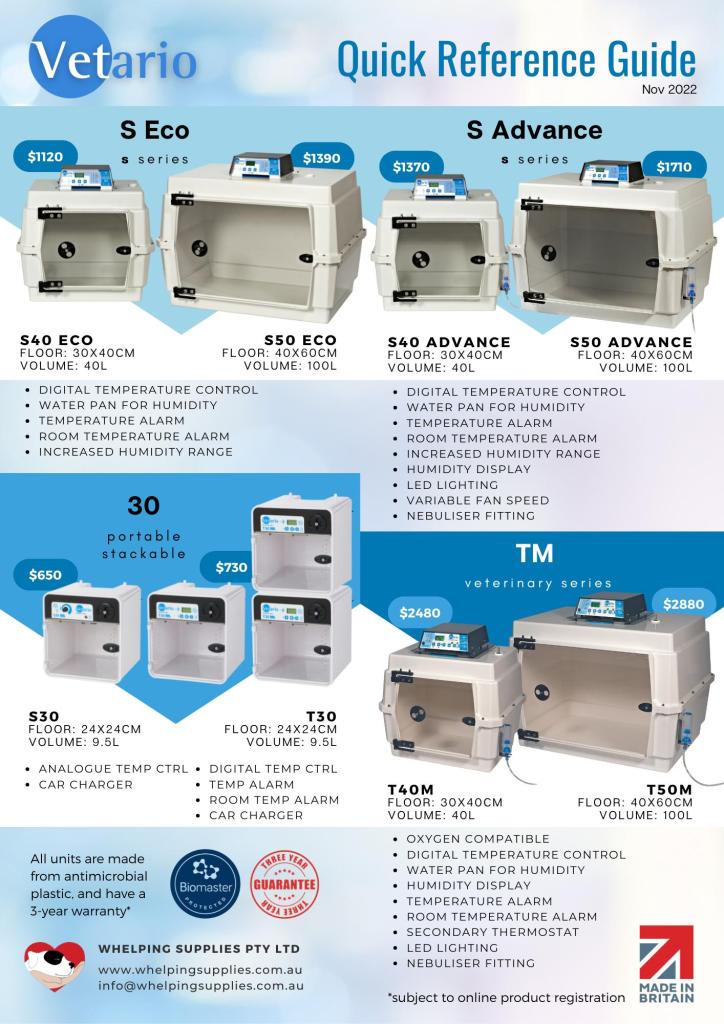The Importance of Proper Heating
Keep Your Litter Safe, Healthy, and Warm.
Heating may be the most understated aspect of your whelping setup. It is vital for the health and prosperity of your litter, and its neglect can have fatal outcomes. Further to this, poor heating has been implicated in fading puppy syndrome. During the first four days post-whelp, the puppies should be kept between 29.5°C to 32°C. Temperature can then be reduced gradually until we have reached about 27ºC by seven to ten days post-whelp. By the end of the fourth week, the temperature can be further reduced to 22°C. It should be noted that the entire room does not need to be kept at this temperature. A warm room with the addition of other heating sources will allow you to achieve these desired temperatures.

Heat is transferred in 3 different forms. These forms are conduction (contact with a heating element), convection (air heating), and radiation (heat radiation from a heating lamp). Ideally, the room that the litter is in is heated using some form of room heating (convection heating). However, often you also need additional supplement heating. These are commonly in the form of heating pads (conduction) and heating lamps (radiation). Rarely will you need to use both of these supplement heating forms together in addition to room heating.
Different situations may warrant the use of one heating method over the other. For example, for large and giant breeds, using heating lamps may be impractical and dangerous as the bitch may risk burning herself when standing up. In these cases, a heating pad is ideal for additional heating. Others may prefer a heating lamp over a heating pad to allow for better drying and heating after the puppies are whelped. To develop a better understanding of these heating types and which might be better for you, we will discuss heating pads and heating lamps below. Additionally, we will discuss Intensive Care Units (ICUs), which are another quality choice for heating, particularly for weak and struggling puppies and kittens.

How can we supply additional heat?
Heating Pads
Heating pads are a reliable way to provide a warm spot in the whelping box. Place them underneath a blanket or towel and not in direct contact with the puppies. Heating pads should also not be so large that they do not allow the puppies to move away from the heat if need be. For this reason, don’t place a heat pad directly in the corner of the whelping box. This then provides a safe unheated perimeter around it. Your bitch will also unlikely want to lie down on the heating pad, as she is likely already running hot; this is normal.
A heating pad may be a more favourable heating option for large to giant breeds. This will omit any risk of the bitch accidentally touching and burning themselves on a overhead heating element. A heating pad may be the best option if there’s no appropriate place to hang or mount a heating lamp.
Heating Lamp
Heating with a lamp has more variabilities compared to convection and conduction heating. The components of a heating lamp include the heating bulb, the lamp shade, and, optionally, a lamp stand. The lamp shade limits heat lost to unnecessary spaces (upwards/sideways) and directs the heat towards the litter. The next element is the heating bulb. Here, there is variety in the type and strength of the bulb. The type of bulb you require depends on your preference. Some heat bulbs produce light (purple and red light), and others don’t, such as carbon fibre and ceramic heat bulbs.
Focusing on the heating aspect of the heat bulb, the strength required will depend on your setup (inside or outside, with or without other room heating, etc.) and the height you have your lamp shade. For example, a 100-watt heating lamp will deliver a different amount of heat from 0.5, 1.0, and 1.5 metres away from the litter. For this reason, we recommend that you use a probe thermometer with heating lamps so that you can assess the amount of heat that is reaching the litter. The most popular wattage is 100 watts, which offers flexibility as you can move it closer or further away to achieve the right temperature. You can achieve this with any wattage, but 75-100 watts is a good middle point to start.
Intensive Care Units (ICUs)
Intensive Care Units (ICUs) are another way of precisely controlling the environment, including temperature, for weak and struggling puppies. Quality ICUs will maintain a consistent and reliable temperature inside. In addition, some units have alarms to indicate significant changes in the set temperature. It is important to note that ICUs cannot maintain a temperature BELOW the ambient room temperature. In these cases, the ICU will continue with ventilation but cannot keep the lower temperature. The ICU may indicate this to you via an alarm. Some models of ICUs may enable you to supplement oxygen. This requires direction from your veterinarian and advanced knowledge. Only some ICUs are oxygen compatible. Never use oxygen with incompatible units, as oxygen carries risk of toxicity, fire and explosion.
Our favourite ICUs are the Vetario® Intensive Care Units, designed and manufactured in England by Brinsea. Brinsea and Vetario continuously work with vets and animal professionals. Their equipment provides the optimal environment for sick and injured animals to make the quickest and safest recovery. The Vetario range aims to meet different needs, including transportable ICUs and oxygen-compatible ICUs. To compare the features of the different Vetario ICUs, look at the infographic below.

Safety and Precaution
Heat
Heat is essential, but too much is also bad, specifically concerning heating lamps that are too close or heating pads that do not enable puppies to move away from the heated area. If the puppies cannot escape from the heat, they are at risk of dying from heat stress. Therefore, when you need to use additional heating, always use a thermometer probe to track the temperature around the puppies. This help you to know if they are receiving enough OR too much heat from the heat lamp or heating pad.
Electrical
As with all things electrical, you should be wary about the accessibility and hazard of cables. Assess the risk of the bitch or puppies chewing on electrical wires or elements (i.e. heating pad) that are connected to electrical outlets daily. Don’t attempt to use electrical items with exposed cable wires as this poses a fire and electrocution risk. You can also use a bitterant spray to deter puppies from chewing on cables.
Final Thoughts
Appropriate heating ensures the best chance for a healthy and happy litter. As with everything involved with puppy and kitten rearing, heating should be continuously monitored and adjusted as needs change. Your choice of heating should be made through an understanding of which style best fits with your setup and with your bitch, as well as your personal preference for the presence or absence of light, additional cost or labour for setting up a suspended heating lamp, etc. Finally, we again urge you to ensure you have a reliable way to monitor the temperature around your litter, such as with a probe thermometer.





Leave a reply